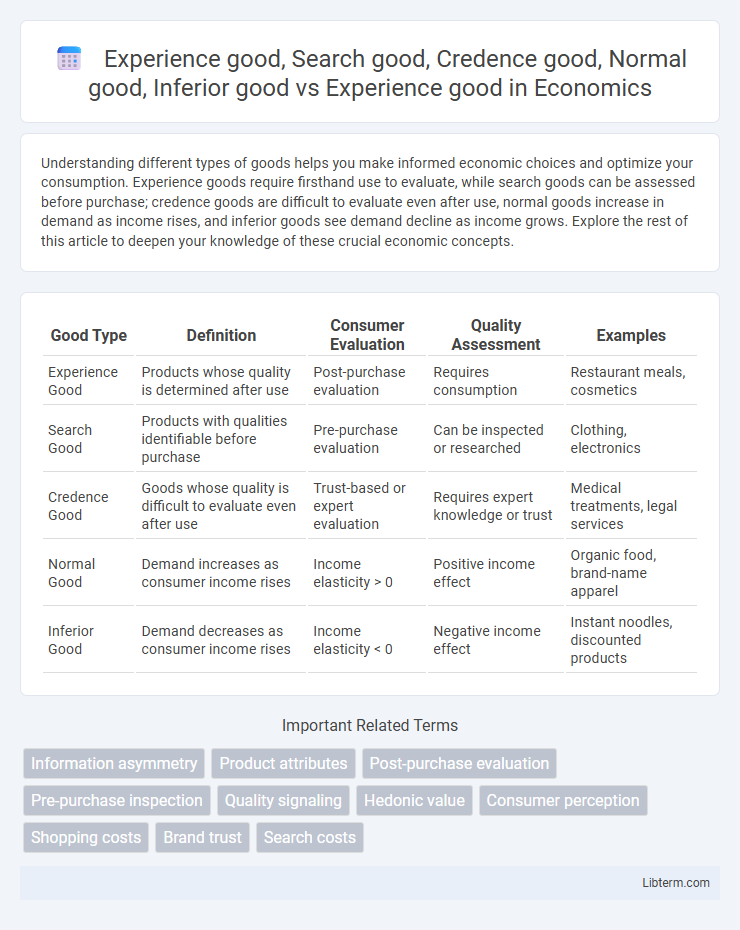Understanding different types of goods helps you make informed economic choices and optimize your consumption. Experience goods require firsthand use to evaluate, while search goods can be assessed before purchase; credence goods are difficult to evaluate even after use, normal goods increase in demand as income rises, and inferior goods see demand decline as income grows. Explore the rest of this article to deepen your knowledge of these crucial economic concepts.
Table of Comparison
| Good Type | Definition | Consumer Evaluation | Quality Assessment | Examples |
|---|---|---|---|---|
| Experience Good | Products whose quality is determined after use | Post-purchase evaluation | Requires consumption | Restaurant meals, cosmetics |
| Search Good | Products with qualities identifiable before purchase | Pre-purchase evaluation | Can be inspected or researched | Clothing, electronics |
| Credence Good | Goods whose quality is difficult to evaluate even after use | Trust-based or expert evaluation | Requires expert knowledge or trust | Medical treatments, legal services |
| Normal Good | Demand increases as consumer income rises | Income elasticity > 0 | Positive income effect | Organic food, brand-name apparel |
| Inferior Good | Demand decreases as consumer income rises | Income elasticity < 0 | Negative income effect | Instant noodles, discounted products |
Understanding Types of Goods: Overview
Experience goods require consumption to assess quality, while search goods allow evaluation before purchase through information gathering. Credence goods challenge buyers as their quality is difficult to verify even post-consumption, unlike normal goods which see demand rise with income increases. Inferior goods, contrasting both experience and search goods, experience demand declines as consumer income grows, highlighting diverse consumer behavior across good types.
What Are Experience Goods?
Experience goods are products or services whose value and quality can only be accurately assessed after purchase and consumption, such as restaurants, cosmetics, or vacations. Unlike search goods, which can be evaluated before purchase through information or inspection (e.g., electronics or clothing), experience goods require firsthand interaction to determine satisfaction. Credence goods differ further, as their quality or benefits may remain uncertain even after use, making consumer trust essential.
Defining Search Goods and Their Characteristics
Search goods are products or services whose qualities and attributes can be evaluated before purchase through research, comparison, and inspection, distinguishing them from experience goods that require consumption to assess quality. Characteristics of search goods include easily accessible information, clear specifications, and the ability to be compared based on price, features, and reviews, which reduces consumer uncertainty prior to buying. Examples include electronics, clothing, and household appliances, where consumers rely on detailed product descriptions, expert opinions, and user ratings to make informed decisions.
Exploring Credence Goods and Consumer Trust
Credence goods, unlike experience goods that reveal their quality after use, have attributes difficult for consumers to evaluate even post-purchase, creating challenges in consumer trust and market efficiency. Exploring credence goods highlights the importance of transparency, third-party certifications, and expert endorsements in building consumer confidence. Trust mechanisms become essential as consumers rely heavily on external information to assess product quality and reduce perceived risk associated with credence goods.
Normal Goods: Meaning and Examples
Normal goods refer to products or services for which demand increases as consumer income rises, reflecting a positive income elasticity of demand. Examples include branded clothing, dining at restaurants, and electronics, which consumers typically purchase more of when their financial situation improves. Unlike experience goods, which require consumption or trial to assess quality, normal goods maintain predictable demand patterns linked closely to economic conditions and income levels.
Inferior Goods: Explanation and Consumer Behavior
Inferior goods are products whose demand decreases as consumers' income rises, contrasting with experience goods whose value is determined post-purchase through usage. Consumers often shift away from inferior goods to normal or credence goods when their economic status improves, reflecting changes in consumption patterns. Understanding consumer behavior towards inferior goods involves analyzing income elasticity and substitution effects that influence purchasing decisions within different income brackets.
Key Differences: Experience Goods vs. Search Goods
Experience goods require consumption before quality assessment, while search goods allow pre-purchase evaluation through information gathering. Credence goods differ as their quality is challenging to evaluate even post-consumption, contrasting with experience and search goods. Normal and inferior goods categorize consumer demand based on income changes but do not focus on information asymmetry like experience and search goods.
Credence Goods vs. Experience Goods: How They Compare
Credence goods are products or services whose qualities are difficult for consumers to evaluate even after consumption, such as medical treatments or legal advice, whereas experience goods allow consumers to assess quality through usage, like food or clothing. Unlike experience goods, credence goods often require trust in the provider or expert opinion due to the information asymmetry involved. This fundamental difference affects purchasing behavior, as consumers rely more heavily on reputation and certifications for credence goods compared to direct personal experience for experience goods.
Normal Goods vs. Inferior Goods: Distinguishing Factors
Normal goods experience increased demand as consumer income rises, reflecting positive income elasticity; examples include organic foods and branded clothing. Inferior goods see demand decrease when income grows, such as generic brands or public transportation. Distinguishing these goods hinges on income elasticity, consumer preferences, and market perception, where normal goods align with improved purchasing power, unlike inferior goods that serve as cost-effective substitutes during lower income periods.
Experience Goods vs. Inferior Goods: Comparative Analysis
Experience goods require consumers to evaluate quality after purchase or use, as their value becomes clear only through direct experience. Inferior goods decrease in demand when consumer income rises, contrasting with experience goods, which maintain or increase demand based on perceived quality and consumer satisfaction. Understanding this distinction helps marketers tailor strategies, emphasizing product trial and quality assurance for experience goods, while pricing and accessibility are critical for inferior goods.
Experience good, Search good, Credence good, Normal good, Inferior good Infographic

 libterm.com
libterm.com